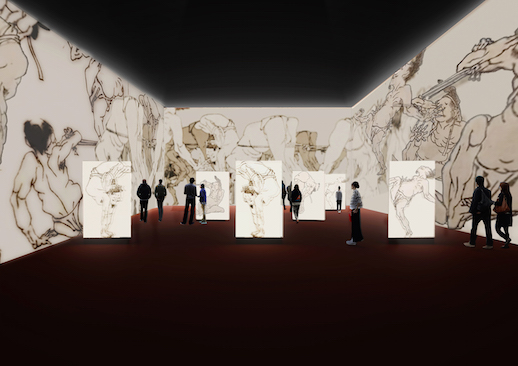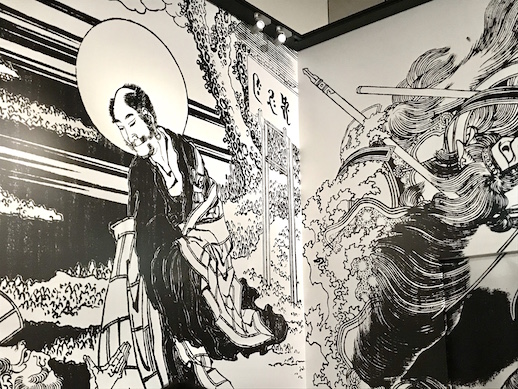The Complete Hokusai
Perhaps no other artist in Japanese history has been more celebrated both in Japan and abroad than Katsushika Hokusai (1760-1849). The so-called “Hokusai Wave” continues to sweep across countries through countless exhibitions and merchandise, and is even slated to appear on a new 1000-yen bill. Among his outstanding prints, this work, Under the Wave off Kanagawa, is likely the most universally recognized.
Hokusai was not only a master of Ukiyo-e prints and painting, he also produced volumes of awe-inspiring sketches compiled in Hokusai Manga, or “Hokusai’s Sketches.” For the first time, with the cooperation of leading Hokusai collector Mitsuru Uragami, the 15 volumes of Hokusai Manga comprising 883 pages and 3,600 illustrations are presented to the public together with Thirty-six Views of Mount Fuji and One Hundred Views of Mount Fuji in the exhibition “The Complete Hokusai” at the Tokyo Midtown Hall until September 17.

Entering the Hokusai Manga-themed first exhibition hall, the atmosphere is jaw dropping. The room is entirely filled with drawings from Hokusai’s historic book, from walls to the floor to display stands. Streamers of the artist’s sketches also hang from the ceiling. Hokusai started the tome in 1811, when he was 51 years old. The first volume was published in 1814, and 12 more volumes by 1820. The last three volumes were published after his death. Block-printed in three colors (black, gray, and cream), the amazing sketches reveal realistic portrayals of people of all ages and statuses and their activities during the Edo period—courtesans, musicians, monks, vendors, farmers, and others. Some volumes focused on landscapes, depicting rice paddies, streets scenes, flora, animals, insects, birds, and fish, as well as mermaids, ghosts, and other supernatural beings.

Volume 3 illustrates the sparrow dance, a traditional performance imitating sparrows’ movements. Hokusai’s lively brush strokes vividly capture the dancers in jackets and hats as though they were actually moving. In Volume 6, we witness various athletic pursuits—men shooting arrows, riding horses, and throwing spears and sticks. Volume 8 offers a bit of humor with the artist’s sketches of acrobatic poses, body sizes and angles, and numerous facial expressions and gestures. Volume 12 presents pages of youkai (folklore spirits) such as tengu (large, red-nosed demons) and rokurokubi (floating head and long-necked creatures), which invite both laughter and fear. Hokusai Manga is the artist’s dedication to life and the natural and supernatural world. Tremendously successful, it travelled to the West, where it became particularly popular after some of its lithographed sketches appeared in a German publication in 1831.

Hokusai began painting at the early age of six. At age 12, he was sent by his father to work at a bookshop, where the young boy surrounded himself with books made from woodcut blocks. This eventually led him to work as a woodcarver apprentice when he was 14 years old. Four years later, he joined the studio of the painter and Ukiyo-e artist Shunsho Katsukawa, where he learned to sketch courtesans and Kabuki actors. He perfected his mastery of woodblock printing and pursued further studies of the Kano School. Gradually, he acquired European styles of art and changed his subjects to landscapes and people’s daily lives. Hokusai’s further association with the Tawaraya School and private commissions increasingly nurtured his popularity in the Western hemisphere.

In the second hall of the exhibition, we see Hokusai’s complete Thirty-six Views of Mount Fuji, which have become beloved all over the world. Produced from around 1830-1832, when Hokusai was in his seventies, the wonderfully colored prints portray the different faces of Mt. Fuji against multiple backdrops in a single day of every season. Another hall is dedicated to the One Hundred Views of Mount Fuji, which the artist produced around 1834-1835. The extremely fine cuts and gradations have made the series a masterpiece in monochrome prints.


A digital version of the Thirty-six Views of Mount Fuji is showcased in Digital Hokusai, a super-immersive theater developed by Toppan Digital using high-definition archive data. Hokusai’s characters dance vibrantly and seem to jump out of the large wall screen made of Japanese paper.

The climax of the exhibition presents Hokusai’s debut into the world of yomihon, a type of narrative book from the Edo period that emphasized storylines more than pictures and often featured imaginary creatures with supernatural powers. The yomihon replaced adult comic books and humorous novels about the shogunate’s policies towards the end of the feudal era. Unlike nishiki-e color prints, yomihon were drawn in black sumi ink. The room is filled with stark black and white graphical clouds, dragons, and rolling waves.

“The Complete Hokusai” is truly overwhelming its impact, not only attesting to Hokusai’s powerful skills in drawing and imagination, but also demonstrating the immense care and importance given to the preservation of historical art. It is a delightful homage for the 260th anniversary of Hokusai’s birth.
This exhibition requires reservations.
Alma Reyes
Alma Reyes



